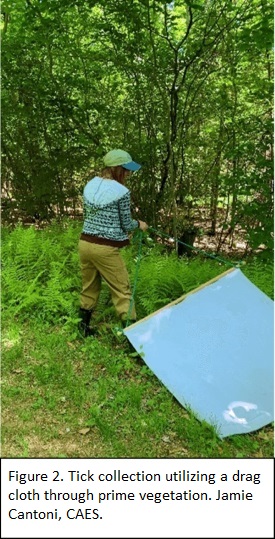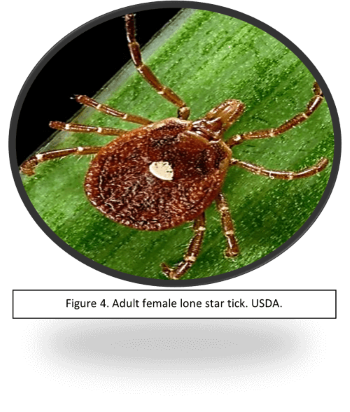The State of Connecticut
Active Tick Surveillance Program

The Active Tick Surveillance Program (ATSP) was established in Connecticut in the spring of 2019 and has continued throughout 2022. With an estimated 476,000 Lyme disease cases treated annually across the United States, not including an additional 17 other tick-borne pathogens of significant medical concern, ticks remain the most reported vector of arthropod-associated illnesses. The surveillance effort allows Station scientists to be proactive in their attempts to monitor shifts in presence, abundance, and distribution of native and invasive tick species and their associated risk for potential novel pathogen and disease transmission. The ATSP, in concert with the state-supported,  passive surveillance Tick Testing Program, further allows scientists to observe the prevalence of current and expanding tick-borne pathogens of significant medical concern including: Borrelia burgdorferi (agent of Lyme disease), Babesia microti (babesiosis), Anaplasma phagocytophilum (anaplasmosis), B. miyamotoi (a relapsing fever Borrelia), B. mayonii (a new Lyme Borrelia), and the Powassan virus (Powassan encephalitis). The program elucidates a more inclusive representation of tick and pathogen abundance and distribution statewide. Our fact sheet is available now: Tracking the Ticks: The Active Tick Surveillance Program
passive surveillance Tick Testing Program, further allows scientists to observe the prevalence of current and expanding tick-borne pathogens of significant medical concern including: Borrelia burgdorferi (agent of Lyme disease), Babesia microti (babesiosis), Anaplasma phagocytophilum (anaplasmosis), B. miyamotoi (a relapsing fever Borrelia), B. mayonii (a new Lyme Borrelia), and the Powassan virus (Powassan encephalitis). The program elucidates a more inclusive representation of tick and pathogen abundance and distribution statewide. Our fact sheet is available now: Tracking the Ticks: The Active Tick Surveillance Program
Tick collection is accomplished by dragging vegetation with a square meter of light-colored cloth (usually canvas or flannel material) attached to a wooden dowel (Figure 2). It is passed over and through vegetation and grasses (see the ATSP's habitat data) along a transect of known length in suitable tick habitat. Host-seeking (or ‘questing’) ticks behave in such a way where they perceive the drag as an animal and potential bloodmeal and intuitively latch onto the cloth.
Each sampling transect covers an area of 750 square meters and is paced accordingly: the drag is examined for ticks approximately every 25 meters for a total of 30 sets per site. In addition to assessing tick abundance, distribution, and infection prevalence, a further objective was the discovery of new and emerging tick invaders on our landscape. View The CAES's map of tick sampling locations.
Table 1. List of tick sampling locations

View the Connecticut Active Tick Surveillance Map.

Since implementing the active surveillance program, new detections of the lone star tick (Amblyomma americanum), a species indigenous to the southern U.S., have occurred in Fairfield, New Haven, New London, and Windham Counties.
 Detections of the exotic Asian longhorned tick (Haemaphysalis longicornis) have been confirmed in Fairfield, New Haven, and New London Counties.
Detections of the exotic Asian longhorned tick (Haemaphysalis longicornis) have been confirmed in Fairfield, New Haven, and New London Counties.
Figure 6. Map highlighting towns where new and invasive tick species have been identified since 2019. Credit: CAES.
Click on the map to view the full-size version
Blacklegged ticks are the primary vector for a suite of medically significant pathogens that can produce several acute and chronic diseases. While these ticks are well known for their ability to transmit Borrelia burgdorferi, the causative bacterium for Lyme disease, they are also competent vectors of several other bloodborne pathogens, with the potential to simultaneously co-infect a host with multiple pathogens. A proportion of ticks collected from the active surveillance effort were screened for 5 unique pathogens (B. burgdorferi, B. miyamotoi, Ba. microti, A. phagocytophilum, and Powassan virus) and concurrently assessed for presence of pathogenic variety.
Summary of Active Tick Surveillance Testing Results
Summaries of the Active Tick Surveillance Program testing results for 2019-2022:
- ATSP Testing Results 2023
- ATSP Testing Results 2022
- ATSP Testing Results 2021
- ATSP Testing Results 2020
- ATSP Testing Results 2019
The Connecticut Active Tick Surveillance Map
Click on the name of a county to view the dropdown menu of tick surveillance data for recent years:
*The infection rates listed here are site-specific information only, and does not reflect overall county infection rates. The number of ticks tested per site range in number (1- >50) and percent totals only reflect any number within that range.



